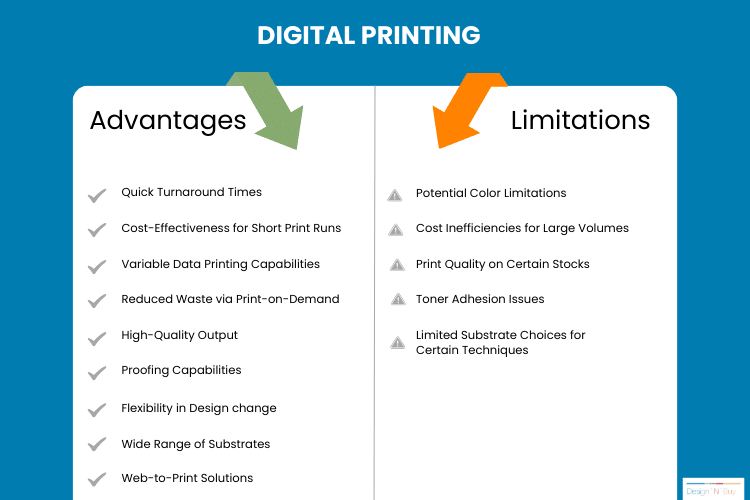A Biased View of Digital Printing
Table of ContentsThe Ultimate Guide To Digital PrintingThe 5-Minute Rule for Digital PrintingNot known Facts About Digital PrintingSome Known Facts About Digital Printing.Facts About Digital Printing RevealedLittle Known Facts About Digital Printing.
has the advantage of only publishing what you need. Offset printing's high setup expenses stop it from being affordable for runs of 100, 10, and even a solitary duplicate. A personalized message is always well gotten by clients. Digital printing permits simple personalization of marketing materials. Smaller sized, more cost-effective sets allow firms individualize each order. Have a sale for the go back to institution. Conversely, you can individualize your newsletters for repeat customers by addressing them by name. Variable information printing, such as direct-mail advertising with customized codes and addresses, is preferably suited for electronic printing. Making modifications to your design at the last min is much simpler with electronic printing. It helps in. And this printing technique warranties precision, so designs will always look the exact same. Alternatives for paper stock, surfaces, and various other features will certainly proceed to expand as innovation advances. When it comes to printing, Seattle Layout and Print is among one of the most reliable firms around. Digital quick printing just requires four actions of style, testimonial, printing and binding to obtain every little thing done. Traditional printing covers a large location and requires a large financial investment in technology. The financial investment of up to 10sof countless yuan has made some tiny and medium financiers discouraged and vulnerable. The core of Digital Express is software. As long as the software application updates can keep up, Digital Express will always be at the center of the printing sector. And a collection of software of numerous thousand yuan is too small contrasted to a set of equipment of a number of
million yuan. 1 or 2 people, a dozen square meters of shop, can open a digital express printing store. Digital fast printing has an exceptional advantage: print as needed - Digital Printing. The modern business model is adaptable and versatile, and it is shown in the published issue. It
is most likely that today's requirements are different from yesterday.
According to PMMI, electronic printing enables brand names and manufacturers to react quickly to consumer demands while boosting the supply chain, decreasing warehousing cost and waste, and appreciating faster time to market. That all audios wonderful, yet exactly how does this technology do all that? The significant differentiator of these technologies is that there are no set-up costs and no plates with electronic printing.
The Ultimate Guide To Digital Printing
According to Wikipedia, the best difference between electronic printing and traditional techniques such as lithography, flexography, gravure, or letterpress - Digital Printing is that there is no requirement to replace printing plates in electronic printing, whereas in these analog printing methods home plates are consistently replaced. This leads to quicker turnaround time and lowers expense when using electronic printing.
Digital printing is very flexible, so it's easy to make changes to see here now the plan design quickly. It all goes back to the plates.
With standard printing approaches, short-run printing is simply not feasible. Because a wonderful style can make or damage your item, digital printing constantly produces top notch, clear and vibrant graphics each time.
Digital printing is the procedure of printing digital-based images straight onto a variety of media substrates. There is no need for a printing plate, unlike with offset printing. Digital documents such as PDFs or desktop computer posting data can be sent directly to the electronic printing machine to publish theoretically, picture paper, canvas, textile, synthetics, cardstock and various other substratums.
Not known Facts About Digital Printing
According to PMMI, digital printing allows brand names and suppliers to react swiftly to customer needs while improving the supply chain, reducing warehousing expense and waste, and enjoying faster time to market. That all audios excellent, however how does this modern technology do all that? The major differentiator of these innovations is that there are no set up costs and no plates with digital printing.
According to Wikipedia, the best difference in between digital printing and traditional techniques such as lithography, flexography, gravure, or letterpress is that there is no need to replace printing plates in electronic printing, whereas in these analog printing methods home plates are repetitively replaced. This causes quicker turnaround time and decreases price when utilizing electronic printing.

The Best Strategy To Use For Digital Printing
More inventory can indicate even more waste later on. With traditional printing approaches, short-run printing is simply not more helpful hints feasible. Since a terrific design can make or damage your item, electronic printing constantly develops top notch, clear and colorful graphics each time. Digital printing on versatile bags includes the brilliant, vibrant, and exact graphics that practically beckon customers to reach out and touch them.

According to PMMI, electronic printing enables brand names and producers to react promptly to client demands while boosting the supply chain, minimizing warehousing expense and waste, and appreciating faster time to market. That all sounds wonderful, however exactly how does this technology do all that? The major differentiator of these technologies is that there are no set up costs and no plates with electronic printing.
Unknown Facts About Digital Printing
This results in quicker turn-around time and lowers cost when making use of electronic printing.
Digital printing is very versatile, so it's simple to make modifications to the bundle style swiftly. It all goes back to the plates.

Top Guidelines Of Digital Printing
Digital printing is the procedure of printing digital-based images directly onto a selection of media substrates. There is no requirement for a printing plate, unlike with offset printing. Digital data such as PDFs or desktop publishing documents can be sent directly to the digital printing machine to publish on paper, photo paper, canvas, material, synthetics, cardstock and various other substratums.